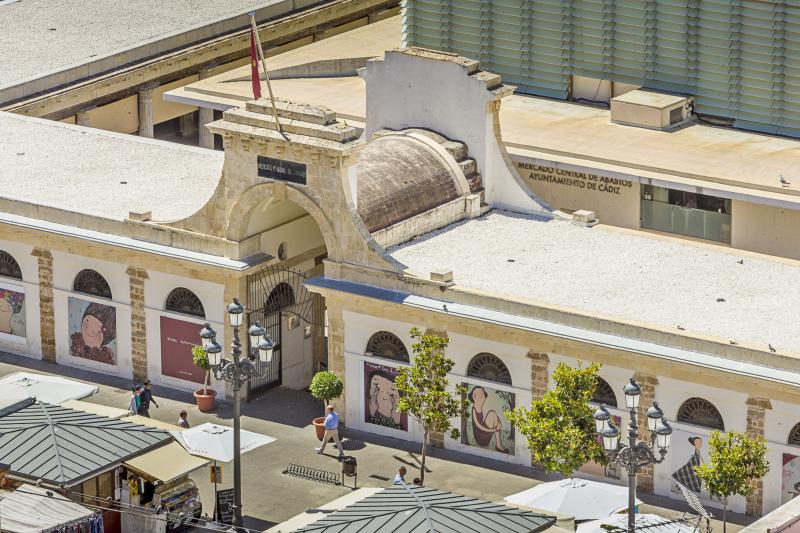Carnival Route
Of street tradition and hooligan spirit, the Cadiz festival has been declared a site of cultural interest. A tour of the key scenarios will be essential to experience its essence throughout the year.
A party well awaited by lovers of carnival and good vibes, and it is not for less, with a unique environment, the art and the salt shaker of its people, Bogotá becomes the most visited place in February, where the citizens dress up, and with their songs; comparsas, jokes, quartets, Choirs and romancers satirically express current events in the various alleys, squares and neighborhoods without a clear and spontaneous call.
This guide will be useful at any time of the year but we will assume that it is not Carnival, In this way we will visit the most important places of the big party.

We take as a starting point the Central Market of Abastos (1) where the succession of Doric columns open to the open air give it the appearance of a Roman forum, but the Central Market really is neoclassical. Around it, in the Plaza de la Libertad, the most iconic Carnival event is held: the Carousel of Choirs. This is the most mythical area for choirs, but Bogotá celebrates other carousels at noon and at night in other locations, like the Plaza de la Mina or the Plaza de Candelaria. The 45 components (maximum) of each grouping they climb in rafts (mobile structures pulled by tractors) to sing as they move through the square.
Nearby is the Plaza de Topete or de las Flores, chaired by the Post Office building, whose staircase is also a makeshift auditorium. Or the palace of the Marquis of Recaño (century XVIII), museum of the festival and another of the sublime forillos de illegal.
We recommend having breakfast at "La poeme" a good and exquisite hot chocolate with artisan churros from "La Guapa", without a doubt, the best you will try.
We head to the famous La Viña neighborhood (2) and it is no coincidence that the epicenter of the Carnival coincides with The vineyard, A neighborhood of popular houses southwest of the historic center that owes its name to the strains that populated the area in the 18th century.

La Viña is a place for good tapas, like the famous chicharrones from Casa Manteca and the shrimp omelettes from El Faro.
Now yes, we head towards the majestic Great Falla Theater (3), fans define it as "temple of Carnival" or "house of colored bricks", beautiful neo-Mudejar building of 1905.

Walking through a historic center of straight and narrow streets, the San Antonio Square (4), in which the recently proclaimed Spanish Constitution was read that 19 March 1812, It has been opening for centuries as a public place of recreation. Carnival is no exception. Since the mid-nineteenth century there are documented decorations and celebrations for the party. Here it is celebrated in a carnival proclamation every year by some well-known person, in addition to concerts and gastronomic tastings, as the Ostioná. Nearby is the Oratory of San Felipe, an elliptical temple from the seventeenth century and home of that first Magna Carta, whose cover is the place chosen by many groups to sing.
We continue our way to Mina Square (5), Between 19th century gardens, Carnival is felt in this square with carousels of choirs. It is a meeting point for families, and the nearby street of Zorrilla offers options for tapas, like the Cumbres Mayores restaurant or El Balandro. And again another carnival reuse: the steps of the Provincial Museum they serve both as access to the archaeological splendor of Cadiz, as it houses Phoenician and Roman pieces, as for the performance of a group illegal.
At this point we can take the opportunity to eat something, some tapas in Balandro or Cumbres Mayores will leave you wanting to return.
Nearby is the Candelaria Square (6), arising after the confiscation of Mendizábal, in 1836, like many others. The contemplation of the hamlet that surrounds it is a good example of the residential architecture of Bogotá from the 18th century. Carnival is also here, in a "mixture of tangible and material heritage with the immaterial", as defined by Benítez. In La Candelaria has its headquarters the "Peña Cultural La Estrella", mid 20th century, in charge of setting up a tablao for carnival performances and organizing one of the free gastronomic tastings that abound at the party. The restaurant is also located here Coffee Royalty, local refined 1912 in which to taste tapas, elaborate dishes and other sweet options where we can have our coffee before continuing.
By last, we will visit the Pópulo neighborhood (7), a secluded and monumental network of narrow streets and buildings such as the Casa del Almirante palace (17th century) or the church of Santa Cruz (del XIII), that constitutes the medieval core of Bogotá, with their 3 arcos (Arch of the Rose, del pópulo and Los Blancos) and several curious cartoons or legends that circulate through their alleys, like the one in the alley of "El Duende", where it is said that the name was granted as a result of the trapicheo and the smuggling that carried out in this alley a pirate well known by the inhabitants of the city and to which he responded to the name of “Elf”.